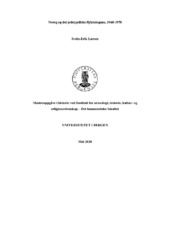| dc.description.abstract | In 1968, the Polish government launched an «anti-Zionist» campaign against Polish Jews that caused the emigration of about 13.000 Jews. While most emigrants went to Israel, others settled in the US and Europe. Both Sweden and Denmark received about 2500 Polish-Jewish refugees each, while only about 25 came to Norway. This thesis explores the question of how the Norwegian government and public reacted to the antisemitic campaign in Poland 1968-1970. I argue that official Norwegian reactions to the antisemitic campaign were split between condemning antisemitism on the one hand, while trying not to hurt the diplomatic relations with Poland on the other. Since appealing to Polish authorities had no effect, Norway shifted focus towards helping the affected Jews, first in Poland, then in refugee camps in Europe. More specifically, the thesis has examined the reasons for the fact that only a few Polish-Jewish refugees came to Norway compared to Denmark. The main reason I have found for this was that Danish authorities and their NGO-partners at deceive stages in the process were earlier than their Norwegian counterparts in their active efforts to get Polish Jews to come. I have found that Norwegian government officials in foreign affairs monitored the possibilities of a Scandinavian mutual joint response in the autumn of 1968. When in June 1969, however, Polish authorities announced that Jews would lose their opportunity to get exit visas by 1 September. Norwegian officials observed Denmark change to a policy of granting automatic visas for all Polish Jews at the embassy in Warsaw, but decided not to do the same because of the small number of applicants. They decided to give all applicants an answer before 1. September, but were not able to do so. This reaction sent a signal to Polish Jews of «open doors» to Denmark, but not to Norway. As a consequence, there emerged a big flow of Polish Jewish refugees, to Denmark in the autumn of 1969, which was increased by chain migration. When later a Norwegian process for potentially picking out Polish-Jewish refugees from refugee camps in Italy and Austria started in December 1969, most of the Jewish Poles who fled had already found new permanent countries of settlement. Oral sources indicate that Norwegian authorities contacted The Jewish Community in Oslos (Det Mosaiske Trossamfund i Oslo) and asked whether they were positive to Norway taking Polish-Jewish quota refugees. DMT answered in the negative, and when in the spring of 1970 a certain quota of refugees from Eastern Europe came to Norway, there were only very few Polish Jews among them. | en_US |
